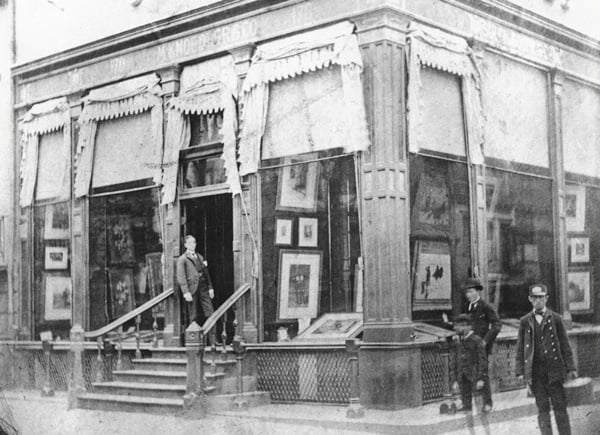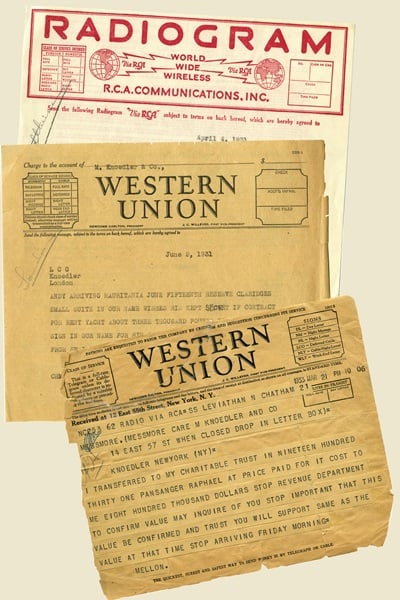Galleries
Getty Spins Web Gold with Knoedler Archive
A Who's Who of Gilded Age collectors is now available online.

A Who's Who of Gilded Age collectors is now available online.

Eileen Kinsella

In what will undoubtedly be viewed as a treasure trove for art historians and art market researchers alike, the Getty Research Institute in Los Angeles has expanded its database of art dealer ledger books by providing free online access to 24,000 records from the historic Knoedler Gallery’s business records.
Books 1 through 6, which span the years 1872 to 1920, are now available online here and others will be added soon, according to a post on the Getty’s Iris blog. “This newly enhanced database can be used to reconstruct the itineraries of thousands of paintings that crossed the Atlantic during the Gilded Age—including many that ended up in major American museums” according to the blog post.
It is rare to find dealer stock books in such pristine form and even more rare for such documents to be made available to the public. The stock books include such information as buyers’ names, sale dates, and selling prices. Further, the Knoedler database is a veritable Who’s Who of collecting in the Gilded Age, including sales to such pioneers as Henry Clay Frick, Jay Gould, Andrew Mellon, the Vanderbilts, and the Rockefellers. Knoedler brokered major sales to important Manhattan collectors, including John Taylor Johnston, the first president of the Metropolitan Museum of Art and Robert L. Stuart, a major donor to the New York Public Library. According to the Getty, the transactions provide “a glimpse of the origins of the great American museums,” particularly since the gallery predates the establishment of most major American institutions.

Charles L. Knoedler (1863–1944), the youngest son of Michael Knoedler, at
the gallery’s fourth location, a rented brownstone at 170 Fifth Avenue and
22nd Street in New York City. Photo: Courtesy Getty Research Institute, Los Angeles
Knoedler, which was founded in 1848, was for decades one of the most esteemed galleries in the world, viewed as “a central force in the evolution of an art market in the US,” according to the Getty blog. The archives provide insight into the movement of major European artworks into American collections. As the Getty points out, it owns more than a dozen paintings and drawings that were either brought to the US by way of Knoedler or sold by the gallery at some point. These include Vincent van Gogh‘s Irises (1889) and Édouard Manet‘s Portrait of Madame Brunet (circa 1863, reworked 1867).

Telegrams to and from Andrew W. Mellon, 1931
and 1933 . Photo: Courtesy Getty Research Institute, Los Angeles
The Getty acquired Knoedler’s archives nearly two years ago, in October 2012, a year after the gallery abruptly shuttered its doors amid a forgery scandal that netted it tens of millions of dollars for works purportedly by blue chip Abstract Expressionist painters. Ultimately the works were revealed as forgeries produced by a Chinese painter in Queens, New York.
A federal investigation and civil lawsuits against Knoedler and its former principals are ongoing (see Knoedler Forger Claims Innocence.)
The comprehensive archive is a vast collection that includes letters, telegrams, albums, sales books, stock and consignment books, card files on clients and artworks, rare photographs, reference photo archives and rare books. At the time the Getty acquired the archives in 2012, Getty Research Institute director Thomas Gaehtgens said there were already plans for “a research project which will reconsider the history of the transfer of European art to the US, based on this outstanding trove.”
In 1847, fast-growing French print publisher Goupil, Vibert & Cie, sent William Schaus to the US to open a Goupil branch, which he did at 289 Broadway, near City Hall. In 1857, the second New York manager, Michael Knoedler, who was trained in Paris by Adolphe Goupil, bought out the New York branch. Knoedler was instrumental in encouraging major US buyers to to focus on Old Master and British art, shifting away from a narrow focus on French Salon paintings.
The Getty Research Institute already owns Maison Goupil’s archives. One notable feature of the latest online archive addition is that users can link Goupil stock numbers found in Knoedler’s records with original Goupil records.